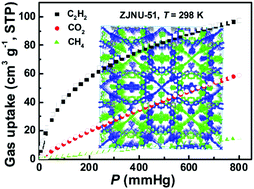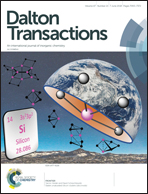A metal–organic framework based on a custom-designed diisophthalate ligand exhibiting excellent hydrostability and highly selective adsorption of C2H2 and CO2 over CH4†
Abstract
The ligand truncation strategy provides facile access to a wide variety of linkers for the construction of MOFs bearing diverse structures and intriguing properties. In this work, we employed this strategy to design and prepare a novel bent diisophthalate ligand, and used it to successfully construct a copper-based MOF ZJNU-51 with the formula of [Cu2L(H2O)2]·5DMF (H4L = 5,5′-(triphenylamine-4,4′-diyl) diisophthalic acid), which was thoroughly characterized by various techniques including FTIR, TGA, PXRD and single-crystal X-ray diffraction. ZJNU-51 is a two-fold interpenetrated network in which the single network consists of dicopper paddlewheel units connected by the organic ligands and contains open channels as well as six distinct types of metal–organic cages. Furthermore, gas adsorption properties with respect to C2H2, CO2, and CH4 were systematically investigated, demonstrating that ZJNU-51 is a highly promising material for C2H2/CH4 and CO2/CH4 separations. Specifically, the IAST adsorption selectivity at 298 K and 1 atm reaches 35.6 and 5.4 for the equimolar C2H2/CH4 and CO2/CH4 gas mixtures, respectively. More significantly, as revealed by PXRD and N2 adsorption measurements, ZJNU-51 exhibits excellent chemical stability, which lays a good foundation for its practical application.



 Please wait while we load your content...
Please wait while we load your content...